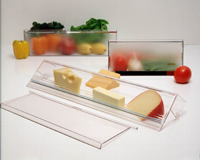Whirlpool Corporation of Evansville, Indiana has found a way to supply refrigerators with clear utility doors that show what's inside the butter compartment, instead of keeping contents hidden from view. with clear utility doors that show what's inside the butter compartment, instead of keeping contents hidden from view.
Using Eastman Chemical Company's Eastar™ PCTG copolyesters, Whirlpool is able to manufacture a door that combines vital characteristics: chemical and impact resistance, plus exceptional clarity. "This door is a critical part for both Whirlpool and their customers," explains Art Benford, Lead Engineer in the Product Engineering division of Whirlpool Corporation. "Customers open and close it a lot, so it must be tough and resist repeated impact. Butter and many other refrigerated foods are very aggressive--their chemical components vaporize, condense, and then weaken the plastic over time, which then causes breakage. Exceptional chemical resistance is of supreme importance in this kind of situation." Whirlpool was not able to use clear doors before, noted Benford, since other available clear plastics were too brittle and not up to the chemical resistance demands of this application. The Eastar™ copolyesters, which feature outstanding chemical resistance, clarity, high gloss and toughness are an excellent match for the stringent requirements of the Whirlpool application. These utility doors are found on Whirlpool's high-end models, including those from Kitchen Aid and are injection molded from Eastar™ copolyesters by Pioneer Plastics, Dixon, Kentucky and Cyanede Plastics, Henderson, Kentucky. Eastar™ PCTG copolyesters are clear amorphous polymers with good processability for large appliance parts when injection molded or extruded into sheet. |